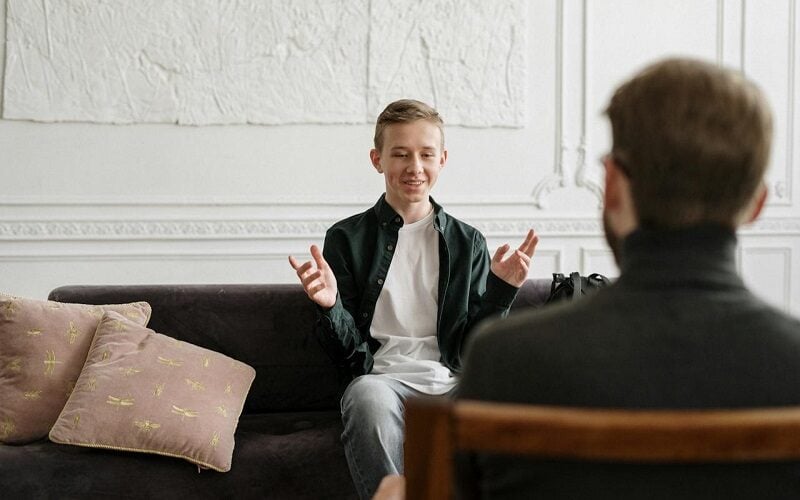We’ve seen a major effort in recent years to raise awareness on the importance of mental health and reduce the stigma connected to seeking help. Yet research still shows that nearly half — 49.5% — of teens in this country will experience a mental health condition at some point.
The teen years are filled with emotional highs and lows, fueled by everything from social pressures to self-esteem issues to academic and family stressors. A survey done by the Centers for Disease Control (CDC) in 2021 found that 42% of high school students feel hopeless or persistent sadness, and almost one-third (29%) have poor mental health.
Individual therapy can become a lifeline to struggling teens dealing with a variety of issues like depression, anxiety, peer pressure, and more. Therapy offers relief by giving teens a safe space, healthy coping skills, and someone to talk to.
The best types of therapy for teens will depend on their individual needs, and understanding how various therapeutic modalities can help is the first step. Keep reading to learn about effective therapy techniques for teens so you can get the right help for your teenager.
1. Cognitive Behavioral Therapy (CBT)
For teens, stress from school, parents, peers, and big life changes can be overwhelming and challenging to navigate, especially when they try to manage things independently. How they react to stress is a big piece of the mental health equation.
Cognitive behavioral therapy (CBT) is an excellent form of therapy for teens because it teaches them to identify and change negative thought and behavior patterns so they can find healthy ways to respond. CBT helps teens learn to manage difficult times by identifying how issues affect them. They learn to spot where unhealthy behavior and thought patterns negatively impact one or more areas in their life. Then, they explore coping tools to change those patterns.
CBT is effective at treating common teen issues like depression and anxiety, and it doesn’t stop there. It can also give teens:
- Better coping skills
- The ability to manage stress
- Increased self-esteem
Several methods are used throughout the CBT experience. Therapists might use any one of these CBT techniques:
- Role-play
- Relaxation and stress relief techniques
- Journaling
- Cognitive restructuring — also known as cognitive reframing
- Guided discovery
- Exposure therapy
“CBT can be particularly helpful when teens are challenged by negative thoughts getting in the way of their confidence in school. For example, they may think they are dumb and cannot succeed no matter how hard they work. In CBT, they can work with their therapist to identify the negative thought pattern and come up with alternative thoughts and coping strategies for the school stressors.”
– Talkspace therapist Jill Daino, LCSW-R, BC-TMH
2. Dialectical Behavior Therapy (DBT)
Dialectical behavior therapy (DBT) can be a powerful type of teen therapy for those dealing with intense or extreme emotions. DBT offers tools to handle stress and regulate feelings, which can ultimately improve relationships. The approach has been found effective for some of the more common teenage mental health concerns like self-harm and suicidal ideation.
It can be very effective in helping teens manage their stress as they navigate confusing and new feelings. It empowers teens to make healthy choices and develop positive relationships rather than reacting impulsively.
DBT combines techniques used in cognitive behavioral therapy with mindfulness practices. A key component of DBT involves learning skills where teens can practice new ways of thinking and behaving. Standard teen therapy techniques often used during DBT sessions include:
- Practicing mindfulness
- Exploring interpersonal effectiveness
- Learning to identify, manage, and tolerate stressors
- Focusing on emotion regulation
3. Interpersonal Therapy (IPT)
Interpersonal therapy (IPT) can be a game changer when it comes to helping teenagers. This type of individual therapy focuses on improving things like relationship quality and social skills, which are commonly at the heart of teen struggles. IPT can also be very effective in treating depression and anxiety, which research shows peaks during the adolescent years for many teenagers.
IPT works on the premise that positive and healthy interactions will improve mental health. This type of therapy helps teens understand how relationships with others impact their lives and teaches them effective ways to communicate their feelings. By focusing on symptom relief through improved interpersonal functioning, IPT can address existing and current issues in teens’ lives instead of focusing on past or developmental problems.
Therapists trained in IPT create an active and supportive environment where teens can explore:
- Relationship conflicts
- Life changes
- Grief
- Challenges in either starting or maintaining healthy relationships
“Interpersonal therapy (IPT) can be particularly helpful with teens as this is a formative time of life where relationships are changing in so many ways, with peers, family, and other trusted adults (teachers, coaches, advisors, etc.). IPT can help teens understand how relationships impact mood and how improving communication skills and working on problem-solving strategies can not only improve the relationship, but can also help the teen’s overall well-being.”
– Talkspace therapist Jill Daino, LCSW-R, BC-TMH
Some common techniques used in IPT include:
- Role-playing
- Guided imagery or rescripting
- Mindfulness and attention regulation
- Bodily work like grounding or deep breathing techniques
- Attention restructuring
4. Acceptance and Commitment Therapy (ACT)
Acceptance and commitment therapy (ACT) helps teenagers accept the hardships they will undoubtedly face at one time or another. Rather than using avoidance, ACT encourages teenagers to embrace their emotions and feelings. It’s a unique type of therapy that teaches adolescents how to live with discomfort and work through pain to achieve their goals.
The main goal of ACT isn’t to reduce symptoms but to promote psychological well-being and flexibility. ACT uses mindfulness techniques to help teens adapt when they face stressful situations or experience uncomfortable or unhealthy thought and behavior patterns.
Therapists use several different techniques during ACT sessions, including:
- Emotion exposure
- Meditation
- Metaphors
- Experiential exercises
5. Exposure Therapy
Exposure therapy is an excellent option for teens dealing with fears or phobias. This specific type of therapy helps teenagers learn to face their fears in a safe and controlled environment. Exposure therapy aims to reduce or eliminate the fear response gradually. By exposing teenagers to what they fear most in a safe and trusting environment, they can learn to cope better, overcome their fears, and live more freely.
Research has shown that exposure therapy can be a helpful treatment option, particularly when combined with other therapeutic modalities. It can effectively treat a variety of things, from phobias to social anxiety disorder to panic disorder to generalized anxiety disorder, and more.
Several techniques and strategies are used during exposure therapy, including:
- Imaginal exposure
- In vivo exposure
- Interoceptive exposure
- Virtual reality (VR) exposure
6. Group Therapy
Group therapy can be transformative for teenagers. In a safe space, surrounded by peers who understand them, teenagers can share experiences and get support while learning from others their age who face similar issues.
According to the American Psychological Association (APA), group therapy offers many benefits, including creating a robust support network far beyond the confines of meetings. Talking and listening to peers can help teens put their problems into perspective. Research shows that group therapy can be as effective and more efficient than one on one individual traditional therapy settings.
Some popular group therapy techniques for teens include:
- Sharing
- Icebreaker activities
- Gratitude acknowledgment
- Visualization
- Writing
7. Family Therapy
Given the critical role the family unit plays when it comes to teen mental health, family therapy is a fitting piece of the puzzle when teens need help. This type of therapy brings immediate family members together in a safe and neutral environment, where everyone can openly discuss concerns and issues and voice their feelings. Therapists play a significant role in this type of therapy, guiding the sessions and helping families understand one another so they can learn to cope with conflict.
Involving parents, siblings, and other family members in therapy ensures they’re part of the healing process. This can be especially important for teens dealing with sensitive issues like abusive relationships, drug and alcohol dependency, self-harm, disordered eating, or any serious mental health condition that affects everyone in the family.
Therapists can choose from various family therapy and counseling techniques. Some popular and effective methods include:
- Role-play
- Mindfulness
- Genograms (visual mapping of family dynamics and history)
- Play therapy
- Reframing and restructuring
- Homework
8. Play or Art Therapy
It’s not uncommon for teenagers to find it difficult to put their feelings into words. Expressing themselves can be tricky as they try to navigate newfound emotions and feelings they’re often experiencing for the first time and don’t necessarily understand. Play or art therapy can be a creative outlet that helps teenagers express their state of mind, offering a unique insight into what they may be dealing with.
How it works: Art and play therapy use creative methods like drawing, sculpting, and painting to help teens express what they’re struggling with, even if they can’t say it out loud.
Why it’s effective: This type of therapy has been found effective because it encourages the exploration of experiences in a safe place without having to recount stressful incidents verbally. Research suggests art therapy’s role in improving mental health is essential and can increase self-esteem and teens’ sense of value.
Techniques used:
Art therapy techniques for teens might include:
- Drawing
- Making collages
- Coloring
- Painting
- Sculpting or photography
Popular play therapy techniques are:
- Emotions ball play therapy
- Feelings charades
- Storytelling
- Role-play
9. Online Therapy
Online therapy offers teens a safe and convenient way to get help from the comfort of their own homes or anywhere they are. The easy, accessible, and flexible format of teen counseling makes scheduling convenient, which can be crucial in teens’ demanding and busy lives. Online therapy also offers privacy and a familiar environment that can make some teens more willing to share.
Research consistently demonstrates that online therapy can be as or more effective as traditional in-person approaches. It offers a stress-free, productive environment where teens can build a trusting relationship with their therapists, with access to guidance and support when and how they need it.
Any techniques used in traditional face-to-face therapy can be applied to the online therapy structure. At Talkspace, teens get online therapy from the comfort of their homes in a virtual method they’re comfortable with. Whether they feel more comfortable with live video sessions, text, or live audio, there’s an effective therapy modality available to them.
“Online therapy is an incredible resource for teenagers; it is private and convenient, and online platforms often offer modalities that work for teenagers’ communication styles. Being able to reach out to a therapist in writing, via audio, or in a live video session offers teens safe ways to connect that truly meets their needs.”
– Talkspace therapist Jill Daino, LCSW-R, BC-TMH
The teenage years can be taxing for both teenagers and their families. Different types of therapy for teens can be crucial in guiding you through the often tumultuous journey. The path to understanding your teenager might start by getting professional help. Talkspace is an online therapy platform that makes getting that help convenient, simple, and affordable. Reach out today to learn more about how Talkspace can help your family.
Sources:
1. Mental Health for Adolescents. HHS Office of Population Affairs. Accessed November 20, 2023. https://opa.hhs.gov/adolescent-health/mental-health-adolescents.
2. Youth risk behavior survey – centers for disease control and prevention. Accessed November 20, 2023. https://www.cdc.gov/healthyyouth/data/yrbs/pdf/YRBS_Data-Summary-Trends_Report2023_508.pdf.
3. Data and statistics on children’s Mental Health. Centers for Disease Control and Prevention. March 8, 2023. Accessed November 20, 2023. https://www.cdc.gov/childrensmentalhealth/data.html#ref.
4. What is exposure therapy? American Psychological Association. 2017. Accessed November 20, 2023. https://www.apa.org/ptsd-guideline/patients-and-families/exposure-therapy.
5. Psychotherapy: Understanding group therapy. American Psychological Association. October 31, 2019. Accessed November 20, 2023. https://www.apa.org/topics/psychotherapy/group-therapy.
6. Pappas S. Group therapy is as effective as individual therapy, and more efficient. Here’s how to do it successfully. Monitor on Psychology – American Psychological Association. 2023;54(2):30-30. https://www.apa.org/monitor/2023/03/continuing-education-group-therapy. Accessed October 20, 2023.
7. Shukla A, Choudhari SG, Gaidhane AM, Quazi Syed Z. Role of art therapy in the promotion of Mental Health: A Critical Review. Cureus. Published online 2022. doi:10.7759/cureus.28026. https://www.ncbi.nlm.nih.gov/pmc/articles/PMC9472646. Accessed November 20, 2023.
8. Langarizadeh M, Tabatabaei M, Tavakol K, Naghipour M, Moghbeli F. Telemental health care, an effective alternative to conventional mental care: A systematic review. Acta Informatica Medica. 2017;25(4):240. doi:10.5455/aim.2017.25.240-246. https://www.ncbi.nlm.nih.gov/pmc/articles/PMC5723163/. Accessed November 20, 2023.
Talkspace articles are written by experienced mental health-wellness contributors; they are grounded in scientific research and evidence-based practices. Articles are extensively reviewed by our team of clinical experts (therapists and psychiatrists of various specialties) to ensure content is accurate and on par with current industry standards.
Our goal at Talkspace is to provide the most up-to-date, valuable, and objective information on mental health-related topics in order to help readers make informed decisions.
Articles contain trusted third-party sources that are either directly linked to in the text or listed at the bottom to take readers directly to the source.




